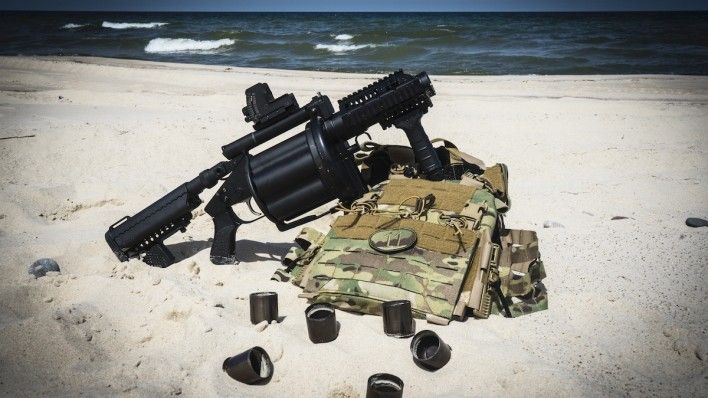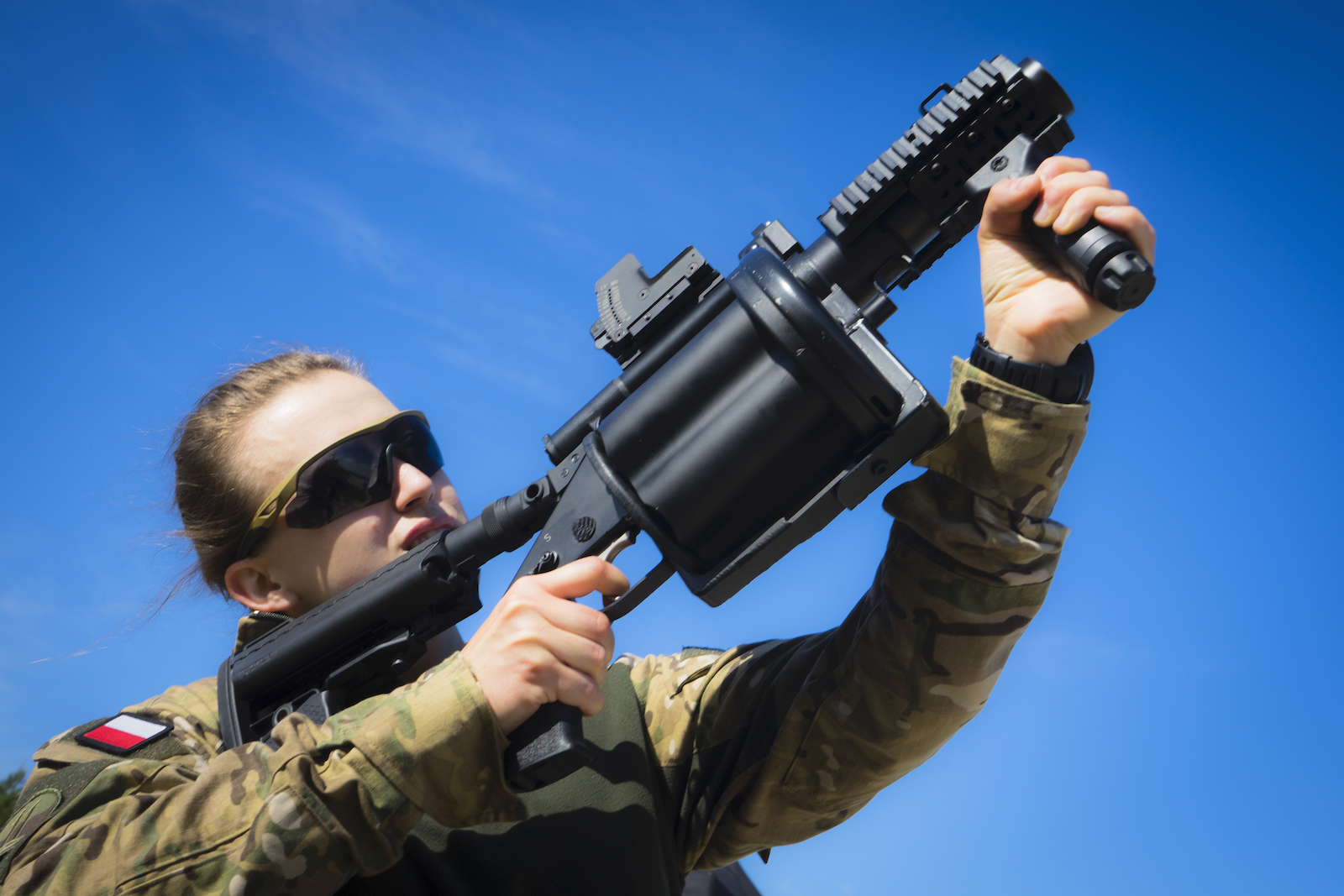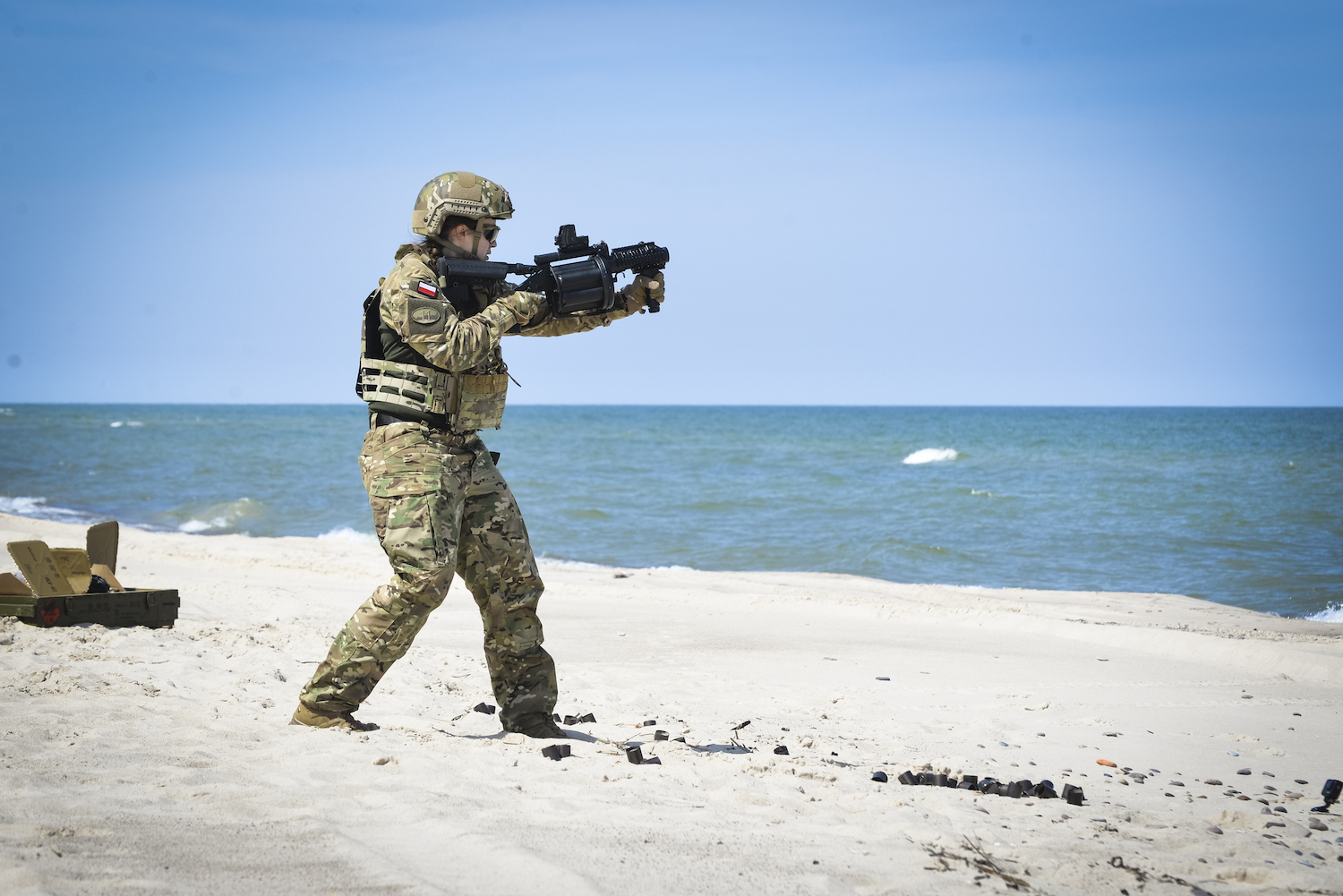Armed Forces
Against Frogmen and Warships. Live Fire Event in Ustka [PHOTOS]

A demonstration of anti-diver 40 mm thermobaric rounds and other naval munitions offered by Works 11 took place at the Central Air Force Training Range in Ustka, Poland. The event involved the use of the Milkor M32A1 multiple grenade launchers along with a presentation of information on mines and mine countermeasures.
Ammunition Designed for Use Against “Frogmen”
Demonstration of the 40x46 mm RLV-AD rounds by the Bulgarian Arsenal company was the main highlight of the event. This low-pressure ammunition has been available in the Arsenal’s offer since 2012. It is a round that has been designed to act against divers in the water, hence its designation (Round Low Velocity – Anti-Diver). The round detonates the TBC-3 thermobaric charge with a high combustion velocity, generating a high-pressure differential. The charge contains an oxidizing agent of its own.
The explosion creates a pressure shockwave that disorients the divers and neutralizes them within a radius of 100 meters. Within a radius of 30 meters, the damage caused by the sudden pressure change is lethal. This is caused by the properties of the water that is far more sensitive to pressure changes than the air.
The RLV-AD grenade has been fitted with a fuse that arms itself after covering a distance of at least 10 meters. Detonation takes place at depth of 5 meters, or when the grenade hits the bottom - that is also a matter of properly setting the round before using it. The fuse has been fitted with a self-destruct device that is activated after 14-19 seconds. The round is 134 mm long and weighs 267 grams. It attains a muzzle velocity of 76 meters per second and can be used at a range of up to 400 meters. Grenades as such can be stored for up to 2 decades.

Ammunition as such can be used for counter-diver defence and it can be fired with the use of the medium- and low-pressure 40x46 mm grenade launchers. These include both underslung as well as stand-alone launchers, including multiple grenade launchers or even automatic grenade launchers. The RLV-AD grenades, during the demonstration, were fired with the use of the Milkor M32A1 multiple grenade launcher manufactured in the US.
Milkor Grenade Launcher: Six Grenades - Three Seconds
The M32A1 is the latest short-barrel derivative of the grenade launcher that has been used by the USMC since 2005 and adopted by the US SOCOM under the Mk 14 Mod 0 designation. The export variant is known as AV-140 MSGL. It could be manufactured in Poland, locally, should this be economically viable - Works 11 assures. Polish JW GROM Unit of the SOF component is the sole Polish military element that currently uses the weapon that is a derivative of the Milkor Mk 1L system offered as MGL-140 - it has been manufactured in the US since the day when the original South African patent validity expired.
It is a semi-automatic grenade launcher fed from a 6-rounds drum with a self-cocking trigger. When the grenade is launched some of the gases are driving the spring-fed ammunition drum to rotate by 60 degrees. A skilled user can fire all of the rounds in 3 seconds and reload the weapon during the next 30 seconds. A safety switch is available. It is ambidextrous and it has been placed above the pistol grip.
The grenade launcher is 739 mm long with the stock unfolded and 648 mm long when it is folded down. The 203 mm long barrel allows the user to fire medium-pressure rounds at a range of up to 800 meters and low-pressure rounds at a range of 375 meters. The weapon’s weight, without the ammunition, is 6.75 kg. The weapon is built around a steel frame holding the ammunition drum. The drum is covered with a cover that turns right, and that features a pistol grip made out of polymer, a trigger mechanism, and a folding stock. All of the steel elements have been coated with NP3 protecting the weapon from the elements. The light aluminum stock features KeyMod mounts that can be used to accessorize the weapon or to attach Picatinny rails.

Underwater Mining and Mine Clearance
Apart from the “practical” demonstration, Works 11 also presented its general offer with regards to littoral operations. The equipment showcased included primarily hardware for minelaying and mine countermeasures. This pertains to large anti-ship mines as well as charges for the divers. Works11 also offers sabotage charges that can work at depths of up to 50 meters. They are attached to the ship’s hull by a diver and they have been fitted with a delay detonator with the delay settable to even several hours.
The three charges offered differ in weight and hull penetration effectiveness, with a similar detonation system (optional delay). The system also reacts when an attempt is made to disengage the mine from the hull or to find the mine (when illuminated, it detonates). The mines can be attached to non-magnetic surfaces while the fuse is activated remotely via an LF programming device.
Blocker mines manufactured by the Finnish Forcit company are another of the showcased solutions - they weigh 710 kilograms and they are purpose-built for warship applications. They can be laid by a myriad of warships, also in an ad hoc setting, thanks to an autonomous containerized minelaying system. The charge itself can be placed at a depth ranging from 10 to 100 meters and it has been fitted with acoustic, pressure, and magnetic sensors programmed to react to specific vessel signatures. The mine remains active for a year - if an extra power supply unit is provided, the period can be twice as long. The mine can be stored for 25 years.
Works 11 also offers the Forcit Boxer mine countermeasure systems that can be used at a depth of up to 120 meters. These weigh around 1 kilogram, making them portable for divers and underwater unmanned vehicles. Boxer has a low magnetic signature while the detonation is triggered by an encoded acoustic sequence that can be sent at a distance of up to 1 kilometer.
Charges such as Boxer or its heavier derivatives may be easily used in conjunction with the Sesam undersea robot that has operational endurance of around 2.5 hours at a depth of up to 100 meters. Alongside acting as a mine countermeasure it could also inspect underwater structures/submerged parts of the vessel, or work with the divers.
Works 11 also offers other naval/coastal defence/maritime route protection systems.
Article prepared in collaboration with the Works 11 Sp. z o.o company
